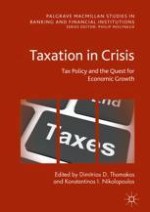2017 | OriginalPaper | Chapter
4. Tax Havens: The Crisis of Transparency
Authors : Mayya Konovalova, Penelope Tuck, Rodrigo Ormeño-Pérez
Published in: Taxation in Crisis
Publisher: Springer International Publishing
Activate our intelligent search to find suitable subject content or patents.
Select sections of text to find matching patents with Artificial Intelligence. powered by
Select sections of text to find additional relevant content using AI-assisted search. powered by
